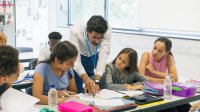A Practical Guide to Planning for Intentional Differentiation
By considering what students need to know, their interests, and how learning will be assessed, teachers can differentiate assignments.
Your content has been saved!
Go to My Saved Content.Differentiating for the needs of all learners is an important focus that many teachers across the world share. We want our students to have a year-plus growth in courses, whether they’re struggling with core basics, are just at the appropriate skill level, or have understanding that exceeds the learning outcomes of the curriculum. These are the key elements to consider in differentiating instruction:
- Planning: Content, processes, and products
- Learner access: Readiness, interests, and learning preferences
- Environment
Much has been written to help teachers think about and provide differentiated experiences for learners that align and explain these elements. However, the question and challenge that I hear and observe from teachers most often is: how do we effectively plan intentional differentiation that we can implement and evaluate with the same confidence and understanding as traditional lessons? The answer that follows is based on a change in how to use the planning elements—content, processes, and products—for differentiation, which is finding traction in classrooms that are using this approach.
A 3-Pronged Approach to Planning for Differentiation
Part 1: Content. Content is what students need to know, understand, and do something with. When identifying these outcomes, we also shape the assessment(s) by how learners can demonstrate what they understand. Success comes from teachers accomplishing two steps for this task.
First, identify the specific skills and concepts that students must achieve. This is what gets measured and analyzed through a variety of assessments. Unpacking the skills and concepts enables teachers to track student learning progress for areas of additional support for learners with significant gaps and learners who are ready for complexity beyond the content expectations of the lesson. This understanding enables teachers, instructional coaches, and supervisors to be on the same page as to what students need to learn through intentional differentiation.
Second, collect data on what the students bring to the focused content. Sometimes, this step is viewed as finding strategies for planning differentiation. That is a mistake. Meeting learner needs means knowing what opportunities they bring to the lesson based on what they already know and what challenges exist, based on gaps in core areas of need. Examples of student data to collect prior to planning include life experiences and interests outside of school and academic skills. Using strategies like K-W-L charts or need to knows is one way to find out what learners already know about the topic. Their level of understanding of the content should be factored into the planning. No student feels engaged with a lesson or session that delivers content they have long since mastered. This stage of planning also helps to confirm gaps in knowledge.
Educators should collect information about students’ interests and passions that may relate to, or give them background for, applications of the content. This data can lead to rich learning experiences, such as providing informational text to read and analyze from articles about sports or Minecraft if many students identify those as areas of interest.
Accomplishing these two steps helps to ensure that the educators feel well prepared about the specific curriculum expectations at a targeted level. It also ensures that teachers are fully aware of what students bring to the content in terms of opportunities and areas of challenge.
Part 2: Processes. Process is about the different ways that students make sense of the content. Students need frequent experiences of sense-making through a variety of different ways and opportunities. Teachers make this happen through lessons that are made up of a series of activities.
Differentiation through processes is applied in one or more of these activities that make up the lesson. Teachers might start with differentiating one activity. As confidence and experience grows, most lesson activities can be differentiated. The focus of intentional differentiation for process is based on students’ content opportunities and challenges. It also incorporates at least one of the learner access elements: readiness, interests, and learning preferences.
Here are two examples.
English: Using details in writing through learning centers. Each center focuses on a different type of detail strategy: example, facts, and sensory detail. Each center includes two options and students choose one to complete.
Math: Understanding the parts and functions of fractions through think dots. Students are put into groups based on their readiness skill level to complete a tiered activity where they all must complete the focus skills. Each group collaborates to solve the six tasks in a random order of choice.
Part 3: Products. Products are the artifacts that students create to show what they know and do not know. These products vary in format both small and large, such as quizzes, reflections, discussions, multimedia, social media tools, and performance tasks.
Intentional differentiation is based on how to leverage what’s known about students’ content opportunities and challenges. Also, use at least one of the learner access elements: readiness, interests, and learning preferences. These experiences range from practice to learn to assessment checks on progress. There is much flexibility to provide learners with a range of opportunities and experiences to help them make connections and extend their learning while maintaining the content focus.
Driving Forward With Differentiation
Explore this approach for reflecting and planning for students’ needs through differentiation. Using content, processes, and products as planning steps provides a clear and concise approach toward choosing strategies and activities based on learner needs that align with the lesson outcomes. This resource curation portal offers ideas to build into your plan, and this differentiation guide offers more insights and a differentiation planning criteria checklist to start your planning journey.
This structure not only empowers student learning but also gives educators common language for collaborative professional opportunities to discuss, implement, and build stronger experiences that meet the needs of all their learners.
